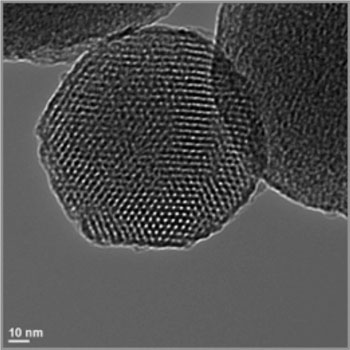Nanoparticle Delivery of Drug Combination Blocks Pancreatic Cancer Growth in Mouse Model
By LabMedica International staff writers
Posted on 07 Apr 2015
Cancer researchers using two potent chemotherapeutic agents combined in one nanoparticle demonstrated significant improvement in the treatment of pancreatic tumors in a mouse model.Posted on 07 Apr 2015
The current frontline method for treatment of pancreatic cancer is a combination of gemcitabine and Abraxane. Gemcitabine is a pyrimidine antimetabolite that interferes with the metabolism and growth of cells by replacing the pyrimidine deoxycytidine in DNA, thereby preventing the DNA from being manufactured or repaired. As a result, cells cannot reproduce and eventually die. Abraxane is nanoparticle albumin-bound form of paclitaxel, a chemotherapy agent made from the needles and bark of certain kinds of yew trees that is used to treat breast cancer. Paclitaxel improves the pharmaceutical efficacy of gemcitabine through suppression of the tumor stroma and inhibiting the expression of the gemcitabine-inactivating enzyme, cytidine deaminase (CDA). Gemcitabine and Abraxane are administered separately, which works to a certain extent, but as the drugs have different half-lives in the body, the combined beneficial effect is not fully synchronized.

Image: TEM (transmission electron micrograph) of a mesoporous silica nanoparticle (Photo courtesy of Wikimedia Commons).
Investigators at the University of California, Los Angeles (UCLA; USA) asked whether it would be possible to develop a mesoporous (containing pores with diameters between two and 50 nanometers) silica nanoparticle (MSNP) carrier to co-deliver a synergistic gemcitabine/paclitaxel combination to pancreatic cancer cells.
High drug loading was achieved by a custom-designed coated lipid film technique to encapsulate a calculated dose of gemcitabine (40% by weight) by using a supported lipid bilayer (LB). The uniform coating of the 65 nanometer nanoparticles by a lipid membrane allowed incorporation of a sub-lethal amount of hydrophobic paclitaxel, which could be co-delivered with gemcitabine to pancreatic cells and tumors.
To demonstrate the in vivo efficacy of the nanoparticle delivery system, mice carrying subcutaneous PANC-1 xenografts received intravenous (IV) injection of paclitaxel-gemcitabine loaded nanoparticles. Results published in the March 16, 2015, online edition of the journal ACS Nano showed that drug co-delivery provided more effective tumor shrinkage than gemcitabine loaded nanoparticles, free gemcitabine, or free gemcitabine plus Abraxane. Comparable tumor shrinkage required co-administration of 12 times the amount of free Abraxane.
HPLC (high pressure liquid chromatograph) analysis of tumor-associated gemcitabine metabolites confirmed that, compared to free gemcitabine, nanoparticle co-delivery increased the phosphorylated, DNA-interactive gemcitabine metabolite 13-fold, while decreasing the inactivated, deaminated metabolite four-fold. IV injection of nanoparticle-delivered gemcitabine/paclitaxel in a PANC-1 orthotropic model effectively inhibited primary tumor growth as well as eliminating metastatic foci. The enhanced in vivo efficacy of the dual delivery carrier could be achieved with no evidence of local or systemic toxicity.
“Instead of just a laboratory proof-of-principle study of any cancer, we specifically attacked pancreatic cancer with a custom-designed nanocarrier,” said senior author Dr. Andre Nel, professor of medicine at UCLA. “In our platform, the drugs are truly synergistic because we have control over drug mixing, allowing us to incorporate optimal ratios in our particles, making the relevance of our models very high and our results very strong.”
Related Links:
University of California, Los Angeles













